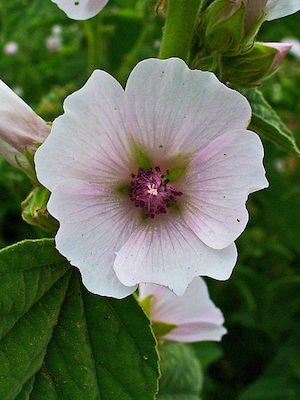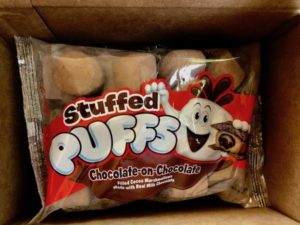Chocolate Stuffed Puffs™ The Perfect New Shelter-in-Place Treat
(Gerry Furth-Sides) This season just in time for much-needed comfort food, chocolate Stuffed Puffs™ marshmallows make their official debut. One bite into this cloud of a marshmallow with its firm chocolate center makes everything seems so much better.S’more, a century-old American tradition, re-born as Stuffed Puffs™, an innovative chocolate-filled marshmallow made with real chocolate was the hit of last summer. 2019.

Masks get our FEDEX driver “back in business”, ringing the doorbell during thee shelter-in-place times. We missed him last month.
Everyone loves marshmallows. Proof is in its popularity since ancient Egyptian times. Still, as when they were first eaten, the marshmallow consists of the same four components: sugar, water, air, and a whipping agent (usually a protein) with brand variations. (see history below) While far behind in chocolate consumption, it remains a very special (and low-calorie, healthy) treat all over the world.
And everyone loves s’mores although that doesn’t go for making them because juggling marshmallows, chocolate bars and graham crackers around a campfire, or hot grill can be tricky, and messy. Stuffed Puffs ingeniously solves the problem of getting the marshmallow hot enough melt the chocolateby putting the chocolate insidethe marshmallow so the chocolate melts while the marshmallow toasts.
STUFFED PUFFS are fluffy, short cylinders with a chocolate filling minus the graham cracker that almost a s’more. Stuffed Puffs creates a center that resembles a whipped Hershey bar in the process. Melting almost instantly on your tongue, it’s wonderful creamy and smooth and showcases the use of real cocoa and cocoa butter. They also be enjoyed indoors by simply putting them on a prong or even a fork and “roasting” them over the stove. And they are something to look forward to with outdoor summer barbecuing.
“The idea was born around a campfire” said Michael Tierney, who graduated from the Culinary Institute of America in Hyde Park, NY in 2010. “It’s a simple idea, but very hard to execute, which is why it hasn’t been done before. I spent seven years figuring out a truly innovative system that breaks the rules of traditional candy making. I’m so excited it’s finally here.”
The company will not stop here. Tierney added. “ We are already at work on different flavor and coating combinations that will make Stuffed Puffs much more than just a campfire-season product.”
Broiling them in the toaster oven works because it allows the puffs to melt evenly onto graham crackers without needing to support their weight. It messiness that separates mediocre s’ mores from genuinely great ones. Available at Walmart for $3.98 a bag.
The history of the marshmallow is as intriguing as its spongy texture, which is corn starch coated for that silky feeling.

The word “marshmallow” stems from the mallow plant, Althaea officinalis, which grows in marshes and is native to certain areas of Europe, North Africa, and Asia. The plant (shown above) has a fleshy stem, leaves, and a five-petaled white flower.
Marshmallow history is not exact, dating back to at least 2000 BC, where privileged Egyptians in ancient Egypt were described as eating them. There it was strictly reserved for gods and royalty, who took the root of the plant and used it as a medicinal to sooth coughs and sore throats and heal wounds. The first marshmallows were prepared by boiling pieces of root pulp with sugar until it thickened. Once thickened, the mixture was strained and cooled.
By the early to mid-1800’s, the marshmallow had made its way to France where confectioners united the plant’s medicinal purposes with indulgent ingredients used by the Egyptian. Production was limited to a small scale because it was so labor intensive.
Small shop Confectioners in early 19th century France pioneered the innovation of whipping up the marshmallow sap and sweetening it, creating a confection similar to the modern marshmallow. An innovative two-day marshmallow drying system streamlined in the late 1800’s with a starch mogul system speeded up production rapidly.
By the early 20th century, and the popular marshmallows were ready for mass consumption. Penny candies, food recipes were sold in tins as penny candy, and began to be seen in a number of food recipes, such as tutti frutti.
In the United States, the United Kingdom, North America, New Zealand and Australia, roasting or toasting of marshmallows over an open flame, preferably outdoor, became enormously popular. Done properly, this produces a caramelized outer skin with a liquid, molten layer underneath.
In 1948, Greek-American confectioner, Alex Doumak, revolutionized the manufacturing process with an extrusion process involving tubes. And by mid-century, automated systems made it possible to produce thousands of pounds of marshmallow a day.



 Gerry Furth-Sides
Gerry Furth-Sides  Barbara Hansen
Barbara Hansen  Chef-owner Alain Cohen
Chef-owner Alain Cohen  Roberta Deen
Roberta Deen  Jose Martinez
Jose Martinez  Nivedita Basu
Nivedita Basu